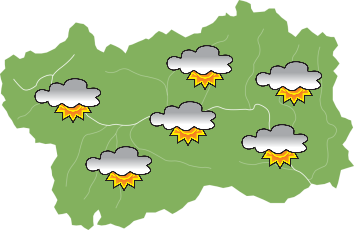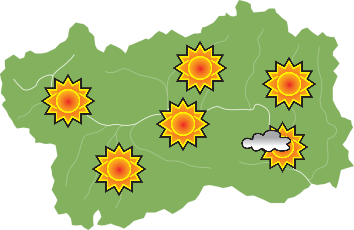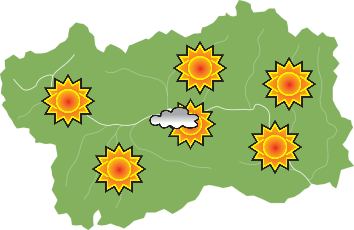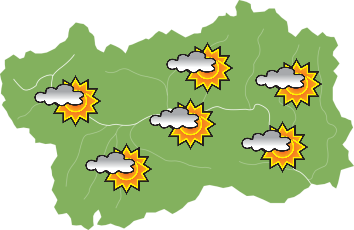Sport Itineraries: Valgrisenche
MOTOTOUR - Saint-Pierre – Valgrisenche
Motorcycling - Saint-PierreTra vigneti e meleti percorrete un tratto della valle centrale e poi imboccate una delle valli più suggestive e selvagge della Valle d'Aosta: la Valgrisenche. Lungo il percorso borghi e castelli medievali invitano alla sosta.
SAINT-PIERRE
Lo scenario è reso fiabesco dal castello che dall’alto della sua rocca domina il paesaggio e risulta ben visibile anche di notte grazie ad un suggestivo sistema di illuminazione. Al suo interno, il museo regionale di scienze naturali per un viaggio alla scoperta di ambienti naturali, flora e fauna della Valle d’Aosta. Ma a Saint-Pierre c' è anche un secondo castello: Sarriod de la Tour, immerso in un meleto, conserva nella meravigliosa “sala delle teste” un prezioso soffitto ligneo della fine del 1400, decorato con figure antropomorfe, mostri, insetti ed animali.
ARVIER E LEVEROGNE
In una conca coltivata a vigneti, Arvier testimonia la caparbietà nell’utilizzare tutta la terra disponibile innalzando nei secoli i terrazzamenti posti sul versante più assolato. Proprio qui si produce il famoso vino rosso Enfer d’Arvier, uno dei primi vini valdostani ad ottenere la denominazione D.O.C..
Attraverserete il borgo medievale di Leverogne e poi, imboccando la strada per la Valgrisenche, potrete vedere il santuario di Rochefort e più avanti sulla sinistra i ruderi del castello di Montmayeur.
LA VALGRISENCHE E LA TRADIZIONE DEI DRAPS
Occhi aperti per non farvi sfuggire nulla, in un viaggio affascinante attraverso la storia, la tradizione e un ambiente suggestivo. La strada sale lungo lo stretto fondovalle, fino a Planaval. Poi la prima piacevole sorpresa: la vallata si apre all’improvviso, dominata sullo sfondo dalla vetta della Grande Sassière e, a destra, dalla Testa del Rutor. Di qui in avanti il percorso risale dolcemente il vasto pianoro fino al capoluogo, Valgrisenche, caratteristico borgo di origini medievali, con il suo campanile romanico. Poco oltre il paese, il lago di Beauregard, annunciato dall'imponente diga. Il luogo ideale per rilassarvi, tra il verde intenso dei boschi di conifere e l’argento della cresta che segna lo spartiacque con la Val d’lsère.
Le nevicate, un tempo, isolavano la valle e le possibilità economiche non erano granché. E così bisognava ingegnarsi, produrre tessuti caldi, pratici e, soprattutto, resistenti. Ecco i famosi Draps della Valgrisenche, realizzati in lana di pecora sugli antichi telai, i métiers. In origine, per renderli impermeabili, venivano fatti infeltrire immergendoli ripetutamente in acqua fredda e battendoli con spazzole di legno. I tempi sono cambiati, ma la tradizione dei Draps, in questa valle, è rimasta. Coperte, tovaglie, indumenti, scialli, rivestimenti per divani e poltrone… ancora oggi vengono realizzati su telai costruiti sull’antico modello. Tessuti esclusivi, che potete ammirare nella mostra permanente nel capoluogo di Valgrisenche.
Le Gare rock climbing wall
Climbing walls - ValgrisencheThe area was created for the 1989 sport climbing competition. There are 4 main sectors: Gare Est, Cheyenne, Gare Ovest, Muro rosso. The climbing style for all routs is small holds and endurance. The anchoring is good and the distance between pitons is never excessive. It is good practice grounds for onsight climbs and for endurance.
The activity requires technical experience. Alpine guide assistance is recommended.
Descent: The stops have chains and bolts and climbers abseil down.
Minimum, maximum and average route difficulty from 6a to 7c, average 6c.
Total number of routes: 45
Average length is 25 meters with a minimum of 15 meters in the cheyenne sector and maximum of 27 in the gare Est sector.
Other rock walls in the area: Miollet - Valgrisenche
Miollet rock climbing wall
Climbing walls - ValgrisencheWall ascent: take the dirt road to the well-marked path. Continue for 10 minutes on the path to the first sector.
The Miollet walls were created by various alpine guides. It is mainly roche moutonnée by the glacier with cracks, crimps and jugs. There are easier routs along the path, ideal for beginners, while the left sector has steeper and more athletically challenging routes. Rock quality is excellent as well as the bolting, never too far apart.
The activity requires technical experience. Alpine guide assistance is recommended.
Descent: Climbers belay down on 60 meter cords or abseil down the few multi-pitch routes.
Minimum, maximum and average route difficulty from 3a to 7c, average 6b.
Other rock walls in the area: Le Gare - Valgrisenche.
Le professeur de la glace
Ice climbing - ValgrisencheThis is the twin waterfall to the right of Revers; a little less difficult compared to its neighbour but equally good. It is dedicated to the “Professor” Patrick Gabarrou, who attended the opening on the day after the climb of the Cascatone di Planaval (this time without E. Marlier). To the right of the waterfall – on the big overhang bordered by stalactites – there is a difficult dry-tooling site created by E. Marlier (fix).
Level: II/4
Length: 150 m
First ascent: N. Berzi, P. Gabarrou, G. Maspes 1995
Altitude: 1700 m
Exposure: West
Coordinates: Lon.: 7,07907 Lat.: 45,656883 - UTM (ED50) - X: 350423,6 Y: 5057919,07
L1: gully with generally fine ice and almost vertical sections. Sometimes soft. 55 metres. Belay on rock to the left (fix).
L2: constant and sustained wall with a vertical sections. 45 metres. Belay on rock to the left (fix).
L3: good vertical pillar followed by a still sustained icy dihedral angle. 30 metres. Belay on rock after the difficulty (fix).
L4: easy short length to exit on the summit’s forest. 20 metres. Belay on tree.
Descent: abseiling along the ice climb.
Text and photos taken from Effimeri barbagli (M. Giglio, 2014), the complete guide to ice climbs in Aosta Valley.
Chalet de l'Epée refuge - Col Fenêtre de Torrent
One-day excursions - ValgrisencheFrom the Chalet de l’Epée refuge, take the alta Via 2 trail (AV2) which goes up to Col Fenêtre across meadows and alpine stone terrain.
Col Bassac Déré
One-day excursions - ValgrisencheFrom the fork before the hamlet of Usellières, where the Valgrisenche paved road comes to an end, take the dirt road that runs alongside the stream and leads to the pastures of Tsalé and Saxe Savoie. From here, continue along route 12, which leads to the Bezzi refuge. Now continue along trail 12C, which, on the orographic right of the stream, goes up the slopes of Grande Traversière,.Bassac Sud and Déré until it reaches the pass.
Grand Alpe crossroad - Lac Saint-Grat
One-day excursions - ValgrisencheFrom Valgrisenche, continue along the paved road that leads to Bonne. Go past this village and ignoring the dirt road on the right for Arp Vieille, you come to another crossroad near Rognettaz Désot and Damon, where you can leave the car.
Ignore the branch of the road that goes down to Usellières, take the branch on the right to Grand’Alpe. Continue along the dirt road signposted 14 and follow it until it ends. From here, continue on the right along trail 14, until you come to Lago San Grato.
In the San Grato valley
One-day excursions - ValgrisencheThe itinerary starts from Rognettaz Desot hamlet, along the road that from Bonne reaches Surrier in the higher part of Valgrisenche at the end of the dam’s lake.
The gravel road starts just before the point where the municipal road begins to go downwill. The itinerary reaches then Grand’Alpe hamlet and continues in the long San Grato valley. You’ll see the typical long pasture houses of Tramouail and later you’ll arrive to the fork for San Grato lake and Col du Mont.
La Frassy - Verconey Damon
One-day excursions - ValgrisencheThe itinerary starts from La Frassy hamlet, that you can reach leaving the regional road near Gerbelle hamlet and moving to the right bank of the stream.
The path, entirely on gravel road, along wide hairpin bends and through larch woods, reaches Verconey Damon hamlet from where you can enjoy a beautiful panorama on the valley that sweeps over the mountains opposite and the Beauregard dam.










